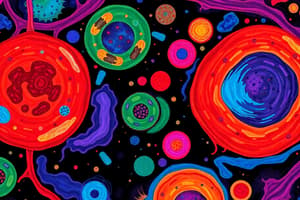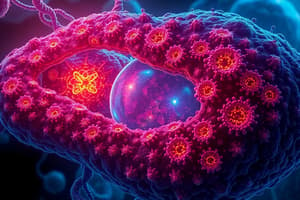Podcast
Questions and Answers
What is the primary process by which plants convert light energy into chemical energy?
What is the primary process by which plants convert light energy into chemical energy?
- Cellular respiration
- Fermentation
- Photosynthesis (correct)
- Chemosynthesis
Which level in the biological taxonomy hierarchy is directly below the kingdom level?
Which level in the biological taxonomy hierarchy is directly below the kingdom level?
- Phylum (correct)
- Species
- Class
- Order
Which term describes the maintenance of stable internal conditions within an organism?
Which term describes the maintenance of stable internal conditions within an organism?
- Homeostasis (correct)
- Metabolism
- Adaptation
- Diversity
What is the study of interactions between organisms and their environment called?
What is the study of interactions between organisms and their environment called?
In the context of ecosystems, what do decomposers primarily do?
In the context of ecosystems, what do decomposers primarily do?
What is the fundamental unit of life?
What is the fundamental unit of life?
Which of the following best describes natural selection?
Which of the following best describes natural selection?
What type of cells lack a nucleus?
What type of cells lack a nucleus?
What is the role of ribosomes in a cell?
What is the role of ribosomes in a cell?
Which process results in the transmission of traits from parents to offspring?
Which process results in the transmission of traits from parents to offspring?
What is the main purpose of the endoplasmic reticulum?
What is the main purpose of the endoplasmic reticulum?
Which statement about evolution is correct?
Which statement about evolution is correct?
What is the primary role of the cell membrane?
What is the primary role of the cell membrane?
Flashcards
What is Ecology?
What is Ecology?
The study of how organisms interact with each other and their environment.
What is Homeostasis?
What is Homeostasis?
The process by which organisms maintain a stable internal environment, despite changes in the external environment.
What is Biological Taxonomy?
What is Biological Taxonomy?
A system of classification that groups organisms based on shared characteristics and evolutionary relationships.
Describe the Flow of Energy in an Ecosystem
Describe the Flow of Energy in an Ecosystem
Signup and view all the flashcards
What is a Biome?
What is a Biome?
Signup and view all the flashcards
What is a cell?
What is a cell?
Signup and view all the flashcards
What are prokaryotic cells?
What are prokaryotic cells?
Signup and view all the flashcards
What are eukaryotic cells?
What are eukaryotic cells?
Signup and view all the flashcards
What is heredity?
What is heredity?
Signup and view all the flashcards
What are genes?
What are genes?
Signup and view all the flashcards
What is evolution?
What is evolution?
Signup and view all the flashcards
What is natural selection?
What is natural selection?
Signup and view all the flashcards
Study Notes
Biology
- Biology is the scientific study of life and living organisms, including their structure, function, growth, origin, evolution, distribution, and taxonomy.
- Key principles of biology include cell theory, evolution, genetics, homeostasis, and energy flow.
- Living organisms exhibit characteristics such as responsiveness to stimuli, growth and development, reproduction, adaptation, and metabolism.
- Cells are the basic structural and functional units of life, and all organisms are composed of one or more cells.
- Prokaryotic cells are simpler, lacking a nucleus and membrane-bound organelles, while eukaryotic cells are more complex, possessing a nucleus and various organelles.
- Biological systems have levels of organization, ranging from atoms and molecules to cells, tissues, organs, organ systems, organisms, populations, communities, and ecosystems.
Cell Structure and Function
- Cells contain various organelles with specific roles, such as the nucleus (controls cell activities), mitochondria (generate energy), ribosomes (protein synthesis), endoplasmic reticulum (protein and lipid synthesis), Golgi apparatus (modifies and packages proteins), lysosomes (break down waste), and vacuoles (storage).
- Cell membrane regulates what enters and exits the cell, maintaining homeostasis.
- Cell walls provide structural support in plant cells and some other organisms.
Genetics
- Heredity is the transmission of traits from parents to offspring via genes.
- Genes are segments of DNA that carry the genetic code for specific traits.
- DNA (deoxyribonucleic acid) is a double helix molecule that carries genetic information.
- RNA (ribonucleic acid) plays a vital role in protein synthesis.
- Meiosis and mitosis are important cellular processes for reproduction and growth.
- Mutations in DNA can lead to variations in traits and can be beneficial, neutral, or harmful.
Evolution
- Evolution is the change in the heritable characteristics of biological populations over successive generations.
- Natural selection is a key mechanism of evolution, where organisms better adapted to their environment are more likely to survive and reproduce.
- Adaptation refers to traits that improve an organism's ability to survive and reproduce in a particular environment.
Levels of Biological Organization
- Atoms combine to form molecules, which assemble into macromolecules (carbohydrates, lipids, proteins, nucleic acids).
- Macromolecules form cells with organelles for specialized functions.
- Similar cells form tissues that create organs working together as organ systems.
- Organisms are individuals that interact with the environment.
- Populations are groups of organisms of the same species in a given area.
- Communities encompass interacting populations in a specific area.
- Ecosystems include communities and their physical environment.
Ecology
- Ecology is the study of the interactions between organisms and their environment.
- Ecosystem dynamics involve energy flow, nutrient cycling, and biodiversity.
- Trophic levels (producers, consumers, decomposers) describe the feeding relationships in an ecosystem.
- Biomes, large-scale ecosystems characterized by climate, vegetation, and animal life, exist across the globe.
Diversity of Life
- All living organisms are classified into a hierarchical system of biological taxonomy, with domains (Bacteria, Archaea, Eukarya), kingdoms, phyla, classes, orders, families, genera, and species.
- Organisms are categorized based on shared characteristics and evolutionary relationships.
Homeostasis
- Homeostasis is the maintenance of stable internal conditions within a cell or organism.
- Organisms use various mechanisms, such as feedback loops, to maintain homeostasis.
- Examples include temperature regulation, water balance, blood sugar regulation, and pH maintenance.
Energy Flow
- Energy, primarily from the sun, drives all biological processes.
- Photosynthesis is the process by which plants and other organisms convert light energy into chemical energy in the form of glucose.
- Cellular respiration releases energy stored in glucose to power cellular activities and produce ATP.
Studying That Suits You
Use AI to generate personalized quizzes and flashcards to suit your learning preferences.




